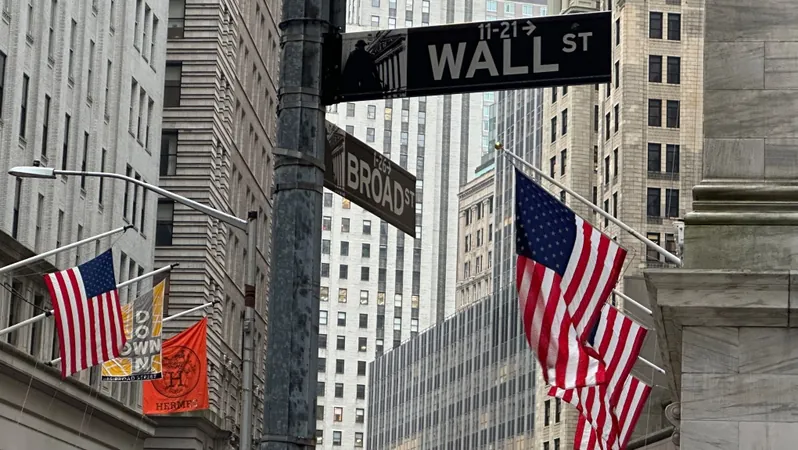
Wall Street Takes a Hit as Big Tech Shares Plunge: What Does It Mean for Investors?
2024-12-29
Author: Amelia
U.S. Stock Markets Close in the Red
U.S. stock markets closed in the red on Friday, capping off a mediocre week despite the overall bullish trends observed this year. The Dow Jones Industrial Average fell by 333 points, equivalent to a 0.78% drop. The S&P 500 decreased by 1.1%, while the Nasdaq Composite saw a sharper decline of 1.5%. This sell-off was largely driven by a downturn in Big Tech stocks.
Major Losses in Big Tech
Noteworthy losses were seen among major players, with Tesla shares tumbling approximately 5%. Additionally, tech giants such as Amazon, Alphabet, Microsoft, and Nvidia all faced declines of about 2%. While these seven prominent tech companies—collectively known as the “Magnificent Seven”—have significantly contributed to market gains in 2023, their recent performances raise concerns about an over-reliance on a select few stocks amid rising interest in artificial intelligence.
Market Dependency Concerns
Keith Lerner, chief market strategist at Truist Wealth, expressed caution over this concentrated market dependency. “If a few of these companies fail to meet elevated expectations, the risk is that they might all decline together,” he stated. Lerner advocates for a more diversified market environment where both mega-cap growth stocks and other sectors flourish, enabling resilience against potential downturns in specific segments.
Cryptocurrency Market Movement
In the cryptocurrency world, Bitcoin saw a significant decline as profit-taking ensued. After soaring to highs of over US$106,000 earlier this month due to speculation about a pro-crypto administration under President-elect Donald Trump, it has fallen back to around US$94,000.
Impact of Rising Treasury Yields
Contributing to the market’s volatility, Treasury yields rose, with the 10-year yield surpassing 4.6%. This shift could divert some trading away from equities as investors reassess their portfolios. The recent holiday week saw lower trading volumes, further amplifying market fluctuations. Historically, this period invites dramatic shifts in stock indexes, often devoid of substantial news, as traders tend to be on vacation.
Historical Market Trends in December
Echoing this trend, market chaos is not foreign to December. Last year, on December 20, the Dow experienced a 500-point drop, and similar movements occurred in preceding years without clear catalysts. Analysts speculated that recessionary fears contributed to market jitters, though many of those fears were unfounded. The infamous market tumble observed in late 2018, where the Dow sank 4,000 points, remains a testament to the unpredictable nature of year-end trading.
Looking Ahead: Stocks vs Bonds
Looking to the future, analysts like Anthony Valeri from California Bank & Trust suggest that stocks are likely to outperform bonds even after a two-year stretch of solid performance. In a note released on Friday, Valeri urged investors to maintain their equity holdings moving into 2025, asserting, “Stocks remain the paramount investment to counter inflation.”
Conclusion: Navigating the Market Rollercoaster
As investors navigate this rollercoaster market landscape, many are left to ponder, will the tech giants rebound, or is a more profound correction on the horizon? Keep an eye on these trends, as they could reshape your investment strategies for the new year.



 Brasil (PT)
Brasil (PT)
 Canada (EN)
Canada (EN)
 Chile (ES)
Chile (ES)
 Česko (CS)
Česko (CS)
 대한민국 (KO)
대한민국 (KO)
 España (ES)
España (ES)
 France (FR)
France (FR)
 Hong Kong (EN)
Hong Kong (EN)
 Italia (IT)
Italia (IT)
 日本 (JA)
日本 (JA)
 Magyarország (HU)
Magyarország (HU)
 Norge (NO)
Norge (NO)
 Polska (PL)
Polska (PL)
 Schweiz (DE)
Schweiz (DE)
 Singapore (EN)
Singapore (EN)
 Sverige (SV)
Sverige (SV)
 Suomi (FI)
Suomi (FI)
 Türkiye (TR)
Türkiye (TR)
 الإمارات العربية المتحدة (AR)
الإمارات العربية المتحدة (AR)